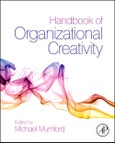Table of Contents
A) Introduction 1.Creativity in Organizations: Importance and Approaches 2. Organizations and Creativity: Trends in Research, Status of Education and Practice, Agenda for the Future 3.Methods in Creativity Research: Multiple Approaches, Multiple Levels 4. Fields, Domains, and Individuals 5. Creativity in Organizations: Facilitators and Inhibitors
B) Individual Level Influences 6. Abilities 7. The Expert Performance Approach and Deliberate Practice: Some Potential Implications for Studying Creative Performance in Organizations 8. Problem Solving 9. Idea Generation and Idea Evaluation: Cognitive Skills and Deliberate Practices 10. The Emotive Roots of Creativity: Basic and Applied Issues on Affect and Motivation 11. Personality 12. Fostering individual creativity through organizational context: A review of recent research and recommendations for organizational leaders
C) Group Level Influences 13. Team Creativity and Innovation: The Effect of Group Composition, Social Processes, and Cognition 14. Collaborative Creativity-Group Creativity and Team Innovation 15. Creativity and Innovation: The Role of Team and Organizational Climate 16. Creativity and Work Context 17. Project Management of Innovative Teams 18. Leadership of Creativity: Entity-Based, Relational, and Complexity Perspectives
D) Organizational Level Influences 19. Organizational Structure and Innovation Revisited: From Organic To Ambidextrous Structurere 20. Planning for Innovation: A Process Oriented Perspective 21. Organizational Learning, Knowledge Management and Creativity 22. Organizing for Change, Innovation, and Creativity
E) Interventions 23. Careers of the Creatives: Creating and Managing the Canvas 24. Can Reward Systems Influence the Creative Individual? 25. Performance management: Appraising performance, providing feedback, and developing for creativity 26. Organizational Development
F) Conclusions 27. Creativity in Organizations: Conclusions







